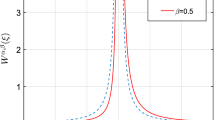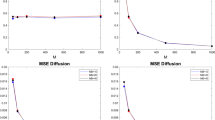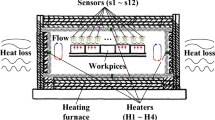Abstract
Inverse problems with spatiotemporal observations are ubiquitous in scientific studies and engineering applications. In these spatiotemporal inverse problems, observed multivariate time series are used to infer parameters of physical or biological interests. Traditional solutions for these problems often ignore the spatial or temporal correlations in the data (static model), or simply model the data summarized over time (time-averaged model). In either case, the data information that contains the spatiotemporal interactions is not fully utilized for parameter learning, which leads to insufficient modeling in these problems. In this paper, we apply Bayesian models based on spatiotemporal Gaussian processess (STGP) to inverse problems with spatiotemporal data and show that the spatial and temporal information provides more effective parameter estimation and uncertainty quantification (UQ). We demonstrate the merit of Bayesian spatiotemporal modeling for inverse problems compared with traditional static and time-averaged approaches using a time-dependent advection–diffusion partial different equation (PDE) and three chaotic ordinary differential equations (ODE). We also provide theoretic justification for the superiority of spatiotemporal modeling to fit the trajectories even if it appears cumbersome (e.g. for chaotic dynamics).

















Similar content being viewed by others
Explore related subjects
Discover the latest articles, news and stories from top researchers in related subjects.References
Abarbanel, H.: Predicting the Future: Completing Models of Observed Complex Systems, vol. 1. Springer, New York (2013). https://doi.org/10.1007/978-1-4614-7218-6
Agarwal, D., Chen, B.-C.: Regression-based latent factor models. ACM Press, New York (2009). https://doi.org/10.1145/1557019.1557029
Agiza, H., Yassen, M.: Synchronization of Rossler and Chen chaotic dynamical systems using active control. Phys. Lett. A 278(4), 191–197 (2001)
Baukal, C.E., Jr., Gershtein, V., Li, X.J. (eds.): Computational Fluid Dynamics in Industrial Combustion. CRC Press, Boca Raton (2000). https://doi.org/10.1201/2F9781482274363
Beskos, A.: A stable manifold MCMC method for high dimensions. Stat. Probab. Lett. 90, 46–52 (2014)
Beskos, A., Roberts, G., Stuart, A., Voss, J.: MCMC methods for diffusion bridges. Stoch. Dyn. 8(03), 319–350 (2008)
Beskos, A., Pinski, F.J., Sanz-Serna, J.M., Stuart, A.M.: Hybrid Monte-Carlo on Hilbert spaces. Stoch. Process. Appl. 121, 2201–2230 (2011)
Beskos, A., Girolami, M., Lan, S., Farrell, P.E., Stuart, A.M.: Geometric MCMC for infinite-dimensional inverse problems. J. Comput. Phys. 335, 327–351 (2017)
Bishop, R.: Chaos. In: Zalta, E.N. (ed.) The Stanford Encyclopedia of Philosophy, 2017th edn. Metaphysics Research Lab, Stanford University, Stanford (2017)
Brooks, C.: Chaos in foreign exchange markets: a sceptical view. Comput. Econ. 11(3), 265–281 (1998). https://doi.org/10.1023/a:1008650024944
Chada, N.K., Stuart, A.M., Tong, X.T.: Tikhonov regularization within ensemble Kalman inversion. SIAM J. Numer. Anal. 58(2), 1263–1294 (2020). https://doi.org/10.1137/19m1242331
Chen, G., Ueta, T.: Yet another chaotic attractor. Int. J. Bifurc. Chaos 9(07), 1465–1466 (1999)
Cleary, E., Garbuno-Inigo, A., Lan, S., Schneider, T., Stuart, A.M.: Calibrate, emulate, sample. J. Comput. Phys. 424, 109716 (2021). https://doi.org/10.1016/j.jcp.2020.109716
Conjard, M., Omre, H.: Spatio-temporal inversion using the selection Kalman model. Front. Appl. Math. Stat. (2021). https://doi.org/10.3389/fams.2021.636524
Cotter, S.L., Roberts, G.O., Stuart, A., White, D.: MCMC methods for functions: modifying old algorithms to make them faster. Stat. Sci. 28(3), 424–446 (2013)
Cressie, N., Wikle, C.: Statistics for Spatio-Temporal Data CourseSmart Series. Wiley (2011). https://books.google.com/books?id=-kOC6D0DiNYC
Dashti, M., Stuart, A.M.: The Bayesian Approach to Inverse Problems, pp. 311–428. Springer, Cham (2017). https://doi.org/10.1007/978-3-319-12385-1_7
de Wiljes, J., Reich, S., Stannat, W.: Long-time stability and accuracy of the ensemble Kalman–Bucy filter for fully observed processes and small measurement noise. SIAM J. Appl. Dyn. Syst. 17(2), 1152–1181 (2018). https://doi.org/10.1137/17M1119056
Echeverría Ciaurri, D., Mukerji, T.: A robust scheme for spatio-temporal inverse modeling of oil reservoirs. Cairns, Australia (2009)
Effah-Poku, S., Obeng-Denteh, W., Dontwi, I.: A study of chaos in dynamical systems. J. Math. 2018, 1–5 (2018)
Evensen, G.: Sequential data assimilation with a nonlinear quasi-geostrophic model using Monte Carlo methods to forecast error statistics. J. Geophys. Res. 99(C5), 10143 (1994). https://doi.org/10.1029/94jc00572
Evensen, G., van Leeuwen, P.J.: Assimilation of Geosat altimeter data for the Agulhas current using the ensemble Kalman filter with a quasigeostrophic model. Mon. Weather Rev. 124(1), 85–96 (1996). https://doi.org/10.1175/1520-0493(1996)124<0085:aogadf>2.0.co;2
Fisher, R.A., Russell, E.J.: On the mathematical foundations of theoretical statistics. Philos. Trans. R. Soc. Lond. Ser. A Contain. Pap. Math. Phys. Character 222(594–604), 309–368 (1922). https://doi.org/10.1098/rsta.1922.0009
Garbuno-Inigo, A., Hoffmann, F., Li, W., Stuart, A.M.: Interacting Langevin diffusions: gradient structure and ensemble Kalman sampler. SIAM J. Appl. Dyn. Syst. 19(1), 412–441 (2020a). https://doi.org/10.1137/19M1251655
Garbuno-Inigo, A., Nüsken, N., Reich, S.: Affine invariant interacting Langevin dynamics for Bayesian inference. SIAM J. Appl. Dyn. Syst. 19(3), 1633–1658 (2020b). https://doi.org/10.1137/19m1304891
Gneiting, T.: Nonseparable, stationary covariance functions for space-time data. J. Am. Stat. Assoc. 97(458), 590–600 (2002). https://doi.org/10.1198/016214502760047113
Goodfellow, I., Bengio, Y., Courville, A.: Deep Learning. MIT Press, Cambridge (2016)
Gupta, A., Nagar, D.: Matrix Variate Distributions. Chapter 2: Matrix Variate Normal Distribution. Chapman and Hall/CRC, New York (2018). https://doi.org/10.1201/9780203749289
Hegazi, A., Agiza, H., El-Dessoky, M.: Controlling chaotic behaviour for spin generator and Rossler dynamical systems with feedback control. Chaos Solitons Fractals 12(4), 631–658 (2001)
Higdon, D., Kennedy, M., Cavendish, J.C., Cafeo, J.A., Ryne, R.D.: Combining field data and computer simulations for calibration and prediction. SIAM J. Sci. Comput. 26(2), 448–466 (2004). https://doi.org/10.1137/S1064827503426693
Horn, R.A., Johnson, C.R.: Topics in Matrix Analysis. Cambridge University Press, Cambridge (1991). https://doi.org/10.1017/CBO9780511840371
Huang, D.Z., Huang, J., Reich, S., Stuart, A.M.: Efficient derivative-free Bayesian inference for large-scale inverse problems. arXiv:2204.04386 (2022). https://doi.org/10.48550/ARXIV.2204.04386
Iglesias, M.A.: A regularizing iterative ensemble Kalman method for PDE-constrained inverse problems. Inverse Prob. 32(2), 025002 (2016). https://doi.org/10.1088/0266-5611/32/2/025002
Iglesias, M.A., Law, K.J.H., Stuart, A.M.: Ensemble Kalman methods for inverse problems. Inverse Prob. 29(4), 045001 (2013). https://doi.org/10.1088/0266-5611/29/4/045001
Ivancevic, V.G., Ivancevic, T.T.: Complex Nonlinearity. Springer, Berlin (2008). https://doi.org/10.1007/978-3-540-79357-1
Jenatton, R., Roux, N., Bordes, A., Obozinski, G.R., Pereira, F., Burges, C., Bottou, L., Weinberger, K.: A latent factor model for highly multi-relational data. In: Pereira, F., Burges, C., Bottou, L., Weinberger, K. (eds.) Advances in Neural Information Processing Systems, vol. 25. Curran Associates, Inc., Red Hook (2012)
Kennedy, M.C., O’Hagan, A.: Bayesian calibration of computer models. J. R. Stat. Soc. Ser. B Methodol. 63, 425–464 (2001)
Krizhevsky, A., Sutskever, I., Hinton, G.E., Pereira, F., Burges, C.J.C., Bottou, L., Weinberger, K.Q.: Imagenet classification with deep convolutional neural networks. In: Pereira, F., Burges, C.J.C., Bottou, L., Weinberger, K.Q. (eds.) Advances in Neural Information Processing Systems, vol. 25, pp. 1097–1105. Curran Associates, Inc., Red Hook (2012)
Lan, S.: Adaptive dimension reduction to accelerate infinite-dimensional geometric Markov chain Monte Carlo. J. Comput. Phys. 392, 71–95 (2019). https://doi.org/10.1016/j.jcp.2019.04.043
Lan, S.: Learning temporal evolution of spatial dependence with generalized spatiotemporal Gaussian process models. J. Mach. Learn. Res. 23(259), 1–53 (2022)
Lan, S., Li, S., Shahbaba, B.: Scaling up bayesian uncertainty quantification for inverse problems using deep neural networks. SIAM/ASA J. Uncertain. Quantif. (to appear) (2022). arXiv:2101.03906
Liz, E., Ruiz-Herrera, A.: Chaos in discrete structured population models. SIAM J. Appl. Dyn. Syst. 11(4), 1200–1214 (2012). https://doi.org/10.1137/120868980
Long, C.J., et al.: State-space solutions to the dynamic magnetoencephalography inverse problem using high performance computing. Ann. Appl. Stat. (2011). https://doi.org/10.1214/11-aoas483
Lorenz, E.N.: Deterministic nonperiodic flow. J. Atmos. Sci. 20(2), 130–141 (1963). https://doi.org/10.1175/1520-0469(1963)020<0130:dnf>2.0.co;2
Marshall, A.W., Olkin, I., Arnold, B.C.: Inequalities: Theory of Majorization and Its Applications, 2nd edn. Springer, New York (2011). https://doi.org/10.1007/978-0-387-68276-1
Mirsky, L.: A trace inequality of john von Neumann. Monatshefte Math. 79, 303–306 (1975)
Morzfeld, M., Adams, J., Lunderman, S., Orozco, R.: Feature-based data assimilation in geophysics. Nonlinear Process. Geophys. 25(2), 355–374 (2018). https://doi.org/10.5194/npg-25-355-2018
Negrini, E., Citti, G., Capogna, L.: System identification through Lipschitz regularized deep neural networks. J. Comput. Phys. 444, 110549 (2021). https://doi.org/10.1016/j.jcp.2021.110549
O’Hagan, A.: Bayesian analysis of computer code outputs: a tutorial. Reliab. Eng. Syst. Saf. 91(10), 1290–1300 (2006). https://doi.org/10.1016/j.ress.2005.11.025
Oakley, J., O’Hagan, A.: Bayesian inference for the uncertainty distribution of computer model outputs. Biometrika 89(4), 769–784 (2002). https://doi.org/10.1093/biomet/89.4.769
Oakley, J.E., O’Hagan, A.: Probabilistic sensitivity analysis of complex models: a Bayesian approach. J. R. Stat. Soc. Ser. B (Stat. Methodol.) 66(3), 751–769 (2004)
Ojeda, A., Klug, M., Kreutz-Delgado, K., Gramann, K., Mishra, J.: A Bayesian framework for unifying data cleaning, source separation and imaging of electroencephalographic signals. bioRxiv (2019)
Ott, E.: Strange attractors and chaotic motions of dynamical systems. Rev. Mod. Phys. 53(4), 655 (1981)
Paciorek, C., Schervish, M., Thrun, S., Saul, L., Schölkopf, B.: Nonstationary covariance functions for Gaussian process regression. In: Thrun, S., Saul, L., Schölkopf, B. (eds.) Advances in Neural Information Processing Systems, vol. 16. MIT Press, Cambridge (2003)
Pasha, M., Saibaba, A.K., Gazzola, S., Espanol, M.I., de Sturler, E.: Efficient edge-preserving methods for dynamic inverse problems (2021). arXiv:2107.05727. https://doi.org/10.48550/ARXIV.2107.05727
Petra, N., Stadler, G.: Model variational inverse problems governed by partial differential equations. Technical Report, The Institute for Computational Engineering and Sciences, The University of Texas at Austin (2011)
Rössler, O.: An equation for continuous chaos. Phys. Lett. A 57(5), 397–398 (1976). https://doi.org/10.1016/0375-9601(76)90101-8
Rossler, O.: An equation for hyperchaos. Phys. Lett. A 71(2), 155–157 (1979). https://doi.org/10.1016/0375-9601(79)90150-6
Sacks, J., Welch, W.J., Mitchell, T.J., Wynn, H.P.: Design and analysis of computer experiments. Stat. Sci. 4(4), 409–423 (1989). https://doi.org/10.1214/ss/1177012413
Schillings, C., Stuart, A.: Analysis of the ensemble Kalman filter for inverse problems. SIAM J. Numer. Anal. 55(3), 1264–1290 (2017a). https://doi.org/10.1137/16M105959X
Schillings, C., Stuart, A.M.: Convergence analysis of ensemble Kalman inversion: the linear, noisy case. Appl. Anal. 97(1), 107–123 (2017b). https://doi.org/10.1080/00036811.2017.1386784
Schneider, T., Lan, S., Stuart, A., Teixeira, J.: Earth system modeling 2.0: a blueprint for models that learn from observations and targeted high-resolution simulations. Geophys. Res. Lett. 44(24), 12396–12417 (2017). https://doi.org/10.1002/2017GL076101
Shcherbakova, A.I., Kupriyanova, Y.A., Zhikhareva, G.V.: Spatio-temporal analysis the results of solving the inverse problem of electrocardiography. J. Phys. Conf. Ser. 2091(1), 012028 (2021). https://doi.org/10.1088/1742-6596/2091/1/012028
Siregar, P., Sinteff, J.-P.: Introducing spatio-temporal reasoning into the inverse problem in electroencephalography. Artif. Intell. Med. 8(2), 97–122 (1996). https://doi.org/10.1016/0933-3657(95)00028-3
Stuart, A.M.: Inverse problems: a Bayesian perspective. Acta Numer. 19, 451–559 (2010)
Villa, U., Petra, N., Ghattas, O.: hIPPYlib: an extensible software framework for large-scale inverse problems governed by PDEs; part I—deterministic inversion and linearized Bayesian inference. ACM Trans. Math. Softw. 47(2), 1–34 (2021). https://doi.org/10.1145/3428447
Wang, K., Hamelijnck, O., Damoulas, T., Steel, M. III, H.D., Singh, A.: Non-separable non-stationary random fields. In: III, H.D. & Singh, A. (eds.) Proceedings of the 37th International Conference on Machine Learning, vol. 119 of Proceedings of Machine Learning Research, pp. 9887–9897. PMLR (2020). http://proceedings.mlr.press/v119/wang20g.html
Webb, G.I., et al.: Latent Factor Models and Matrix Factorizations, pp. 571–571. Springer, Berlin (2011). https://doi.org/10.1007/978-0-387-30164-8_887
Woolrich, M., Jenkinson, M., Brady, J., Smith, S.: Fully Bayesian spatio-temporal modeling of FMRI data. IEEE Trans. Med. Imaging 23(2), 213–231 (2004). https://doi.org/10.1109/tmi.2003.823065
Yang, Y.: Source-space analyses in meg/eeg and applications to explore spatio-temporal neural dynamics in human vision. Ph.D. thesis (CMU) (2017). https://kilthub.cmu.edu/articles/Source-Space_Analyses_in_MEG_EEG_and_Applications_to_Explore_Spatio-temporal_Neural_Dynamics_in_Human_Vision/6723065/1. https://doi.org/10.1184/R1/6723065.V1
Yang, S.-K., Chen, C.-L., Yau, H.-T.: Control of chaos in Lorenz system. Chaos Solitons Fractals 13(4), 767–780 (2002)
Yao, B., Yang, H.: Physics-driven spatiotemporal regularization for high-dimensional predictive modeling: a novel approach to solve the inverse ECG problem. Sci. Rep. (2016). https://doi.org/10.1038/srep39012
Yassen, M.: Chaos control of Chen chaotic dynamical system. Chaos Solitons Fractals 15(2), 271–283 (2003)
Zammit-Mangion, A., Wikle, C.K.: Deep integro-difference equation models for spatio-temporal forecasting. Spat. Stat. 37, 100408 (2020). https://doi.org/10.1016/j.spasta.2020.100408
Zhang, B., Cressie, N.: Bayesian inference of spatio-temporal changes of arctic sea ice. Bayesian Anal. 15(2), 605–631 (2020). https://doi.org/10.1214/20-ba1209
Zhang, Y., Ghodrati, A., Brooks, D.H.: An analytical comparison of three spatio-temporal regularization methods for dynamic linear inverse problems in a common statistical framework. Inverse Prob. 21(1), 357–382 (2005). https://doi.org/10.1088/0266-5611/21/1/022
Acknowledgements
SL is supported by NSF grant DMS-2134256.
Author information
Authors and Affiliations
Corresponding author
Additional information
Publisher's Note
Springer Nature remains neutral with regard to jurisdictional claims in published maps and institutional affiliations.
Appendices
Appendix A Proofs
Theorem
(3.1) If we set the maximal eigenvalues of \(\textbf{C}_\textbf{x}\) and \(\textbf{C}_t\) such that \(\lambda _{\max }(\textbf{C}_\textbf{x})\lambda _{\max }(\textbf{C}_t)\le \sigma ^2_\epsilon \), then the following inequality holds regarding the Fisher information matrices, \({{\mathcal {I}}}_\text {\tiny S}\) and \({{\mathcal {I}}}_\text {\tiny ST}\), of the static model and the STGP model respectively:
If we control the maximal eigenvalues of \(\textbf{C}_\textbf{x}\) and \(\textbf{C}_t\) such that \(\lambda _{\max }(\textbf{C}_\textbf{x})\lambda _{\max }(\textbf{C}_t)\le J\lambda _{\min }(\Gamma _\text {obs})\), then the following inequality holds regarding the Fisher information matrices, \({{\mathcal {I}}}_\text {\tiny T}\) and \({{\mathcal {I}}}_\text {\tiny ST}\), of the time-averaged model and the STGP model respectively:
Proof
Denote \(\textbf{Y}_0=\textbf{Y}-\textbf{M}\). We have \(\Phi _*(u)=\frac{1}{2}\textrm{tr}\left[ \textbf{V}_*^{-1} {\textbf{Y}}^{{\textsf{T}}}_0 \textbf{U}_*^{-1} \textbf{Y}_0\right] \) with \(*\) being S or ST. \(\textbf{U}_\text {\tiny S}\), \(\textbf{V}_\text {\tiny S}\), \(\textbf{U}_\text {\tiny ST}\) and \(\textbf{V}_\text {\tiny ST}\) are specified in (16). We notice that both \(\textbf{U}_*\) and \(\textbf{V}_*\) are symmetric, then we have
Due to the i.i.d. assumption in both models, \(\textbf{Y}_0\) is independent of either \(\frac{\partial \textbf{Y}_0}{\partial u_i}\) or \(\frac{\partial ^2 \textbf{Y}_0}{\partial u_i \partial u_j}\). Therefore
For any \(\textbf{w}=(w_1,\ldots ,w_p)\in {{\mathbb {R}}}^p\) and \(\textbf{w}\ne \textbf{0}\), denote \({{\tilde{\textbf{w}}}}:= \sum _{i=1}^p w_i \textrm{vec}\left( \frac{\partial \textbf{Y}_0}{\partial u_i}\right) \). To prove \({{\mathcal {I}}}_\text {\tiny ST}(u) \ge {{\mathcal {I}}}_\text {\tiny S}(u)\), it suffices to show \({\tilde{\textbf{w}}}^{{\textsf{T}}}(\textbf{V}_\text {\tiny ST} \otimes \textbf{U}_\text {\tiny ST})^{-1} {{\tilde{\textbf{w}}}} \ge {{{\tilde{\textbf{w}}}}}^{{\textsf{T}}}(\textbf{V}_\text {\tiny S} \otimes \textbf{U}_\text {\tiny S})^{-1} {{\tilde{\textbf{w}}}}\).
By [Theorem 4.2.12 in Horn and Johnson (1991)], we know that any eigenvalue of \(\textbf{V}_* \otimes \textbf{U}_*\) has the format as a product of eigenvalues of \(\textbf{V}_*\) and \(\textbf{U}_*\) respectively, i.e. \(\lambda _k(\textbf{V}_* \otimes \textbf{U}_*) = \lambda _i(\textbf{V}_*)\lambda _j(\textbf{U}_*)\), where where \(\{\lambda _j(M)\}\) are the ordered eigenvalues of M, i.e. \(\lambda _1(M)\ge \cdots \ge \lambda _d(M)\). By the given condition we have
Thus it completes the proof of the first inequality.
Similarly by the second condition, we have
and complete the proof of the second inequality. \(\square \)
Lorenz inverse problem: comparing posterior estimates of parameter u for two models (time-average and STGP) in terms of relative error of median \(\textrm{REM}=\frac{\Vert {{\hat{u}}} - u^\dagger \Vert }{\Vert u^\dagger \Vert }\). Each experiment is repeated for 10 runs of EnK (EKI and EKS respectively) and shaded regions indicate 5–95% quantiles of such repeated results
Rössler inverse problem: comparing posterior estimates of parameter u for two models (time-average and STGP) in terms of relative error of median \(\textrm{REM}=\frac{\Vert {{\hat{u}}} - u^\dagger \Vert }{\Vert u^\dagger \Vert }\). Each experiment is repeated for 10 runs of EnK (EKI and EKS respectively) and shaded regions indicate 5–95% quantiles of such repeated results
Chen inverse problem: comparing posterior estimates of parameter u for two models (time-average and STGP) in terms of relative error of median \(\textrm{REM}=\frac{\Vert {{\hat{u}}} - u^\dagger \Vert }{\Vert u^\dagger \Vert }\). Each experiment is repeated for 10 runs of EnK (EKI and EKS respectively) and shaded regions indicate 5–95% quantiles of such repeated results
Theorem
(3.2) If we choose \(\textbf{C}_\textbf{x}=\Gamma _\text {obs}\) and require the maximal eigenvalue of \(\textbf{C}_t\), \(\lambda _{\max }(\textbf{C}_t)\le J\), then the following inequality holds regarding the Fisher information matrices, \({{\mathcal {I}}}_\text {\tiny T}\) and \({{\mathcal {I}}}_\text {\tiny ST}\), of the time-averaged model and the STGP model respectively:
Proof
Denote \(\textbf{Y}_0=\textbf{Y}-\textbf{M}\). We have \(\Phi _*(u)=\frac{1}{2}\textrm{tr}\left[ \textbf{V}_*^{-1} {\textbf{Y}}^{{\textsf{T}}}_0 \textbf{U}_*^{-1} \textbf{Y}_0\right] \) with \(*\) being T or ST. \(\textbf{U}_\text {\tiny T}\), \(\textbf{V}_\text {\tiny T}\), \(\textbf{U}_\text {\tiny ST}\) and \(\textbf{V}_\text {\tiny ST}\) are specified in (16).
By the similar argument of the proof in Theorem 3.1, we have
For any \(\textbf{w}=(w_1,\ldots ,w_p)\in {{\mathbb {R}}}^p\) and \(\textbf{w}\ne \textbf{0}\), denote \(\textbf{W}:= \sum _{i,j=1}^p w_i \textrm{E}\left( \frac{\partial {\textbf{Y}}^{{\textsf{T}}}_0}{\partial u_i} \textbf{U}_*^{-1}\frac{\partial \textbf{Y}_0}{\partial u_j} \right) w_j\). We know \(\textbf{W}\ge \textbf{0}_{J\times J}\). It suffices to show \(\textrm{tr}[\textbf{V}_\text {\tiny ST}^{-1}\textbf{W}]\ge \textrm{tr}[\textbf{V}_\text {\tiny T}^{-1}\textbf{W}]\).
By the corollary (Marshall et al. 2011) of Von Neumann’s trace inequality (Mirsky 1975), we have
where \(\{\lambda _j(M)\}\) are the ordered eigenvalues of M, i.e. \(\lambda _1(M)\ge \cdots \ge \lambda _d(M)\). The only non-zero eigenvalue of \(\textbf{V}_{\tiny T}^-=J^{-2} (\varvec{{1}}_J {\varvec{{1}}}^{{\textsf{T}}}_J)\) is \(\lambda _1(\textbf{V}_{\tiny T}^-)=J^{-1}\). Therefore, we have
where \(\lambda _J(\textbf{V}_\text {\tiny ST}^{-1}) = \lambda _1^{-1}(\textbf{C}_t)\ge J^{-1}\) and \(\lambda _j(\textbf{V}_\text {\tiny ST}^{-1}), \lambda _j(\textbf{W})\ge 0\). \(\square \)
Appendix B More numerical results
Rights and permissions
Springer Nature or its licensor (e.g. a society or other partner) holds exclusive rights to this article under a publishing agreement with the author(s) or other rightsholder(s); author self-archiving of the accepted manuscript version of this article is solely governed by the terms of such publishing agreement and applicable law.
About this article
Cite this article
Lan, S., Li, S. & Pasha, M. Bayesian spatiotemporal modeling for inverse problems. Stat Comput 33, 89 (2023). https://doi.org/10.1007/s11222-023-10253-z
Received:
Accepted:
Published:
DOI: https://doi.org/10.1007/s11222-023-10253-z










